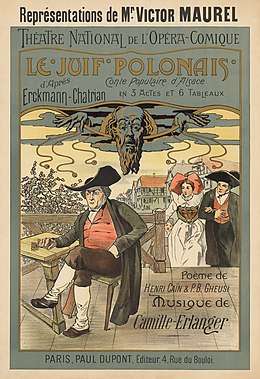Le Juif Polonais
Le Juif Polonais (translation: The Polish Jew) is a 1900 opera in three acts by Camille Erlanger composed to a libretto by Henri Caïn.

It was adapted from the 1867 stage play Le juif polonais by Erckmann-Chatrian. The 1867 play was translated into English in 1871 as The Bells by Leopold Lewis and for years was one of actor Henry Irving's most successful roles.[1]
Plot
A melodramatic climax occurs when the sound of sleigh bells at his daughter's wedding (in Act II) reminds the innkeeper Mathias of the Jew he had murdered 15 years previously. Dreaming (in Act III) that he is being tried for the murder, he confesses the details of the attack and his disposal of the body, and dies of a heart attack.
Performances
The opera was first performed in Paris at the Opéra Comique on 11 April 1900, when the cast included Gustave Huberdeau, the tenor Edmond Clément as Christian and Victor Maurel as Mathias. The role of Mathias's daughter Suzelle was created by Julia Guirandon.[2]
Gustav Mahler chose to present the work in Vienna in 1906, where it proved a dismal failure. The plot was found to be thin, and the music insufficient to support interest. According to Alma Mahler, her husband had been reminded, when he heard the work in Paris, of his own Fourth Symphony by the sleighbells. Viennese critics rated the work as inferior to another on the same theme by Karel Weis, produced in Vienna in 1902.[3] Nevertheless the opera remained in the repertory in France until the 1930s.[4]
Bibliography
- La Grange, Henry-Louis, de. Gustav Mahler: Vienna, Triumph and disillusion, Oxford, 1999
- Tchamkerten, Jacques. "Erlanger, Camille." Grove Music Online. Oxford Music Online. 22 Dec. 2008. Accessed via subscription
Notes
- George Rowell (1953) Nineteenth Century Plays
- New York Times review of the premiere, April 29, 1900
- La Grange (1999) pp. 485–7
- Tchamkerten, Grove Music Online